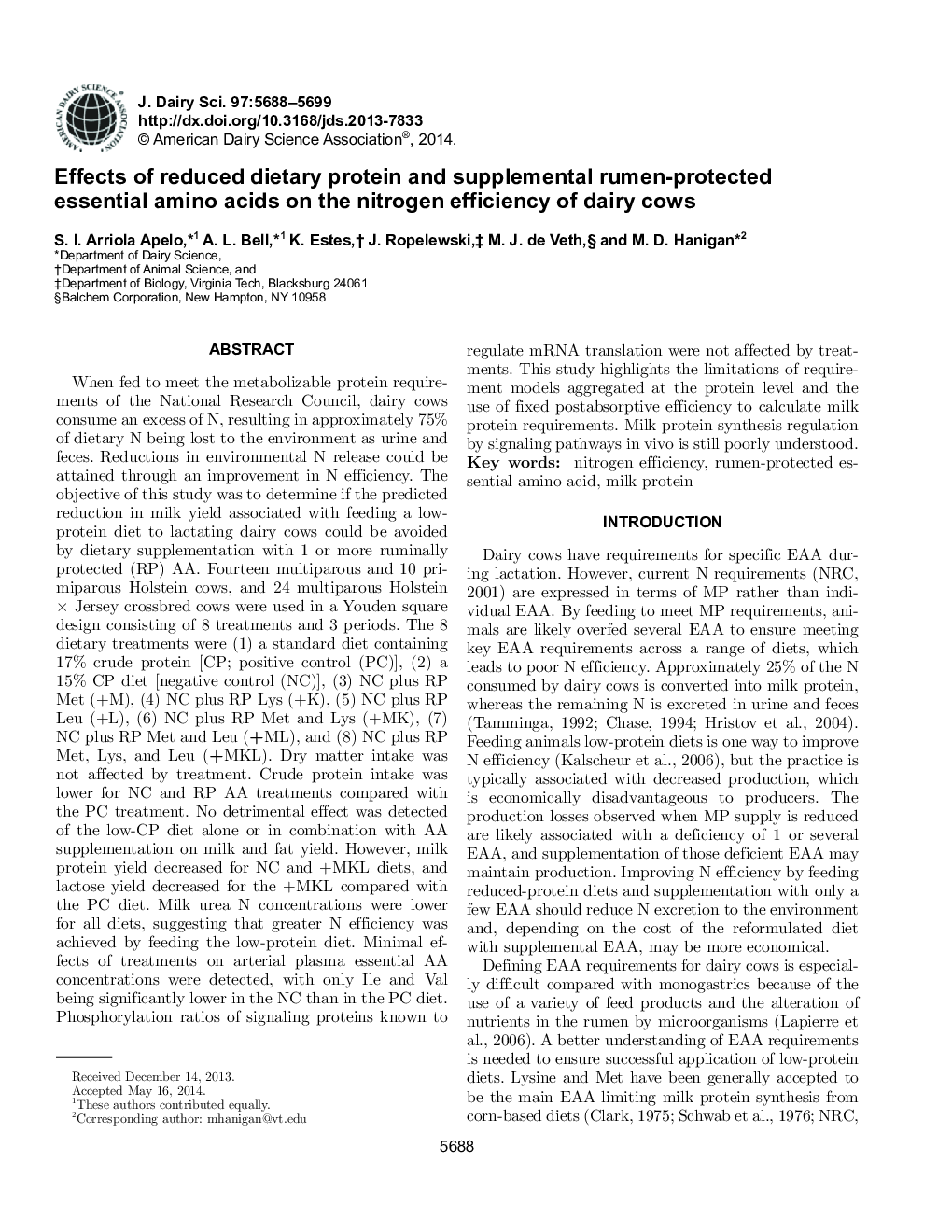| کد مقاله | کد نشریه | سال انتشار | مقاله انگلیسی | نسخه تمام متن |
|---|---|---|---|---|
| 10974140 | 1108022 | 2014 | 12 صفحه PDF | دانلود رایگان |
عنوان انگلیسی مقاله ISI
Effects of reduced dietary protein and supplemental rumen-protected essential amino acids on the nitrogen efficiency of dairy cows
ترجمه فارسی عنوان
اثرات کمبود پروتئین و اسیدهای آمینه ضروری حاوی مقادیر رژیم غذایی بر عملکرد نیتروژن گاوهای شیری
دانلود مقاله + سفارش ترجمه
دانلود مقاله ISI انگلیسی
رایگان برای ایرانیان
کلمات کلیدی
بازده نیتروژن، اسید آمینه ضروری محافظت شده از شکمبه، پروتئین شیر
موضوعات مرتبط
علوم زیستی و بیوفناوری
علوم کشاورزی و بیولوژیک
علوم دامی و جانورشناسی
چکیده انگلیسی
When fed to meet the metabolizable protein requirements of the National Research Council, dairy cows consume an excess of N, resulting in approximately 75% of dietary N being lost to the environment as urine and feces. Reductions in environmental N release could be attained through an improvement in N efficiency. The objective of this study was to determine if the predicted reduction in milk yield associated with feeding a low-protein diet to lactating dairy cows could be avoided by dietary supplementation with 1 or more ruminally protected (RP) AA. Fourteen multiparous and 10 primiparous Holstein cows, and 24 multiparous Holstein à Jersey crossbred cows were used in a Youden square design consisting of 8 treatments and 3 periods. The 8 dietary treatments were (1) a standard diet containing 17% crude protein [CP; positive control (PC)], (2) a 15% CP diet [negative control (NC)], (3) NC plus RP Met (+M), (4) NC plus RP Lys (+K), (5) NC plus RP Leu (+L), (6) NC plus RP Met and Lys (+MK), (7) NC plus RP Met and Leu (+ML), and (8) NC plus RP Met, Lys, and Leu (+MKL). Dry matter intake was not affected by treatment. Crude protein intake was lower for NC and RP AA treatments compared with the PC treatment. No detrimental effect was detected of the low-CP diet alone or in combination with AA supplementation on milk and fat yield. However, milk protein yield decreased for NC and +MKL diets, and lactose yield decreased for the +MKL compared with the PC diet. Milk urea N concentrations were lower for all diets, suggesting that greater N efficiency was achieved by feeding the low-protein diet. Minimal effects of treatments on arterial plasma essential AA concentrations were detected, with only Ile and Val being significantly lower in the NC than in the PC diet. Phosphorylation ratios of signaling proteins known to regulate mRNA translation were not affected by treatments. This study highlights the limitations of requirement models aggregated at the protein level and the use of fixed postabsorptive efficiency to calculate milk protein requirements. Milk protein synthesis regulation by signaling pathways in vivo is still poorly understood.
ناشر
Database: Elsevier - ScienceDirect (ساینس دایرکت)
Journal: Journal of Dairy Science - Volume 97, Issue 9, September 2014, Pages 5688-5699
Journal: Journal of Dairy Science - Volume 97, Issue 9, September 2014, Pages 5688-5699
نویسندگان
S.I. Arriola Apelo, A.L. Bell, K. Estes, J. Ropelewski, M.J. de Veth, M.D. Hanigan,
